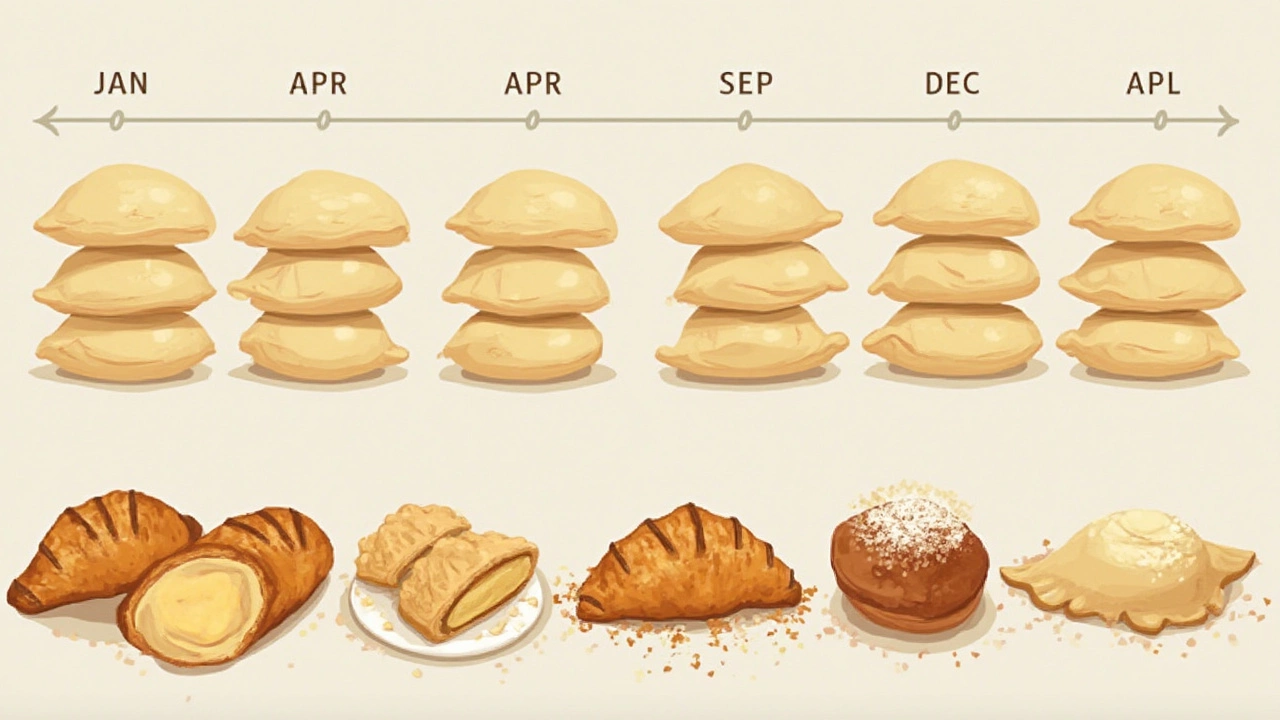
You grab a block of frozen pastry dough from the back of your freezer, but here’s the big question: is it still any good? Freezer burn, dried-out edges, weird smells—these can ruin even your best batch of pastel dough. So what’s the real shelf life if you want that perfect, flaky crunch?
Pastry dough handles the cold like a champ, but it has its limits. If you’re storing homemade or store-bought pastel dough, keeping it in a deep freeze at -18°C (0°F) lets it last up to 3 months without noticeable loss in flavor or texture. Push it past that, and things can get dicey: flavors might dull, the color can change, and thawed dough can end up tough or soggy instead of crisp.
- Freezer Shelf Life: The Real Limit
- How to Tell If Dough Has Gone Bad
- Best Storage Tricks for Freezing Pastry Dough
- Defrosting: The Right Way to Use Frozen Dough
Freezer Shelf Life: The Real Limit
Here’s the straight talk: pastry dough keeps well in the freezer, but it’s not immortal. Most kitchen pros agree pastel dough lasts up to three months when frozen at -18°C (0°F). After that, quality drops. The crust can dry out, flavors start to fade, and you risk a tough texture when baking. So don’t stash it and forget about it for a year.
If you’re curious how long is too long, check out these common dough lifespans in the deep freeze:
| Type of Dough | Ideal Freezer Life | Quality After Thawing |
|---|---|---|
| Homemade pastel dough | Up to 3 months | Tastes fresh, keeps flakiness |
| Store-bought pastel dough | 2 to 3 months | Good texture, may dry slightly |
| Dough left longer than 3 months | More than 3 months | Possible freezer burn, flavor loss |
The main thing that kills dough? Freezer burn. That’s what happens when air hits the dough and leaves frosty, dried patches. Even wrapped tight, dough won’t stay perfect forever. If you’re trying to keep things longer, it just won’t have the same taste or crunch.
Quick tip: Always write the date on the package, so there’s no guessing down the line. And don’t try refreezing once you’ve thawed it—this messes up the texture for good. Stick to the three-month rule, and you’ll always have pastel dough ready for action without any surprises.
How to Tell If Dough Has Gone Bad
Nothing cramps your style faster than pulling out old pastry dough only to find it's turned weird. But what are the real warning signs? The first thing you want to check for is color changes. If your dough looks gray instead of pale yellow or white, that's a red flag. Dark or discolored spots usually mean freezer burn or worse, mold starting up. Either way, that batch isn’t safe to use anymore.
Next up: smell. Fresh pastry dough should have a mild, almost neutral aroma. If you’re catching whiffs of sourness, anything cheesy or musty, it’s time to toss it. Strange smells are a dead giveaway that yeast or bacteria have started to take over, even in cold storage. According to the U.S. Department of Agriculture,
"Off odors—even when the dough is still cold—are one of the first signs that frozen dough has gone bad, and it should be discarded immediately."
Texture is another biggie. Good pastel dough will be firm and slightly pliable when thawed. If it feels slimy, sticky, or extra hard, something's off. It might look dry or have ice crystals all over — clear signs it’s lost too much moisture or was unfrozen then refrozen.
- Color shift: Avoid gray, green, or odd dark patches.
- Strange smells: Toss it out if it has any sour, bitter, or off odors.
- Texture: Pass on dough that’s slimy, sticky, or dry with lots of crystals.
- Mold spots: Any fuzz or green bits mean it’s not safe.
If you're in doubt, it's always safer to play it cautious. No pastel is worth a trip to the doctor!

Best Storage Tricks for Freezing Pastry Dough
If you want your pastry dough to stay just as yummy after freezing, there are a few tricks that really make a difference. Don’t just toss that dough in the freezer and hope for the best. Small mistakes can mess up the texture fast.
Start with airtight sealing. Air is your enemy—too much, and your dough gets dried out or covered in freezer burn. An easy hack is to wrap your dough tightly in plastic wrap, then stick it in a zip-top bag. If you have a vacuum sealer, even better, because it pulls out all the air.
Don’t forget to label your dough. Write the date on the bag or container so you know when it went in. Trust me, after a month, all those wrapped balls look the same, and nobody wants to gamble on mystery dough.
Want easy organization and thawing? Flatten your dough into a disc or rectangle before freezing. This way it freezes and defrosts faster and takes up less space. And if you’re prepping for a crowd, chunk your dough into portions you’ll actually use, so you only thaw what you need.
| Storage Type | Protection Level | Recommended Max Time |
|---|---|---|
| Plastic Wrap + Zip Bag | Good | 3 months |
| Vacuum Sealed | Excellent | 4-5 months |
| Just Zip Bag | Fair | 1 month |
- Freeze on a flat baking sheet first, then move to a bag to hold the shape.
- If the dough is homemade, chill it before freezing—cold dough sticks together less and thaws with better texture.
- Never refreeze dough that's already been thawed. It’ll taste weird and won’t puff up right.
If you’re short on bags, use a double layer of foil for extra protection. Just keep it snug. With these little habits, you’ll keep your pastel dough tasting fresh and flaky when you finally need it.
Defrosting: The Right Way to Use Frozen Dough
Getting your pastry dough from rock-hard to ready-for-action isn’t rocket science, but there’s a wrong way and a right way. Quick tip: never just toss frozen dough on the counter at room temperature, thinking you’ll speed things up. That can leave you with soggy spots and dried-out bits, definitely not what you want for a perfect pastel.
The best plan? Let the dough thaw slowly in your fridge. Here’s how you do it, step by step:
- Move the frozen dough (still wrapped) to the fridge the night before you need it.
- Allow it to sit for at least 8 hours, up to 12 hours. The slow thaw keeps moisture locked in and prevents the dough from getting sticky or tough.
- If you’re in a hurry, set the wrapped dough in a sealed bag and pop it in a bowl of cold water—it’ll be ready in about 1-2 hours. Never use hot water or a microwave unless you want patchy, half-cooked spots and sad, chewy crusts.
After thawing, let the dough sit on the counter for 10-15 minutes before rolling out. This takes the chill off and makes it easier to work with.
If you feel lost, here’s a handy table for quick reference:
| Defrosting Method | Time Needed | Quality Rating |
|---|---|---|
| Fridge (best) | 8-12 hours | ⭐⭐⭐⭐⭐ |
| Cold Water (okay in a pinch) | 1-2 hours | ⭐⭐⭐⭐ |
| Room Temperature | 1-3 hours | ⭐⭐ |
| Microwave | 5-10 minutes | ⭐ |
Here’s what’s crucial: never refreeze dough that has already thawed. It messes up the texture, kills the flavor, and just makes for a miserable pastel experience. The bottom line—if you want your pastry dough to roll out smooth and bake up flaky, keep it cool during thawing and be patient with the process.








Write a comment